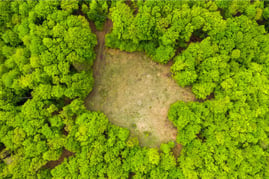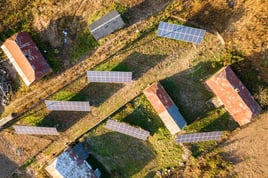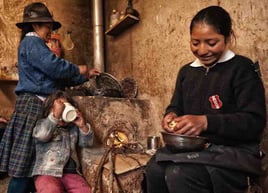I progetti di riduzione del carbonio possono rimuovere le emissioni di carbonio dall'atmosfera o prevenirne il rilascio.
Sono idonei a generare crediti di carbonio (1 credito di carbonio corrisponde a 1 tonnellata metrica di CO2 assorbita o ridotta) e vengono scambiati attraverso il Mercato Volontario del Carbonio.
Non è sempre facile orientarsi tra le diverse tipologie di progetti disponibili e selezionare quella che meglio si adatta alla tua azienda. ClimateSeed offre 7 diverse tipologie di progetti di riduzione delle emissioni che generano crediti di carbonio:
1. Gestione Forestale e Uso del Suolo

I progetti di gestione forestale e uso del suolo includono una serie di iniziative volte a promuovere la gestione e l'utilizzo sostenibile delle risorse forestali e del suolo.
Questi progetti comprendono attività come la pianificazione forestale, la produzione sostenibile di legname, pratiche agroforestali e l'ottimizzazione dell'uso del suolo.
2. Energie Rinnovabili

Le energie rinnovabili sono fonti naturali di energia che si rigenerano spontaneamente. Rappresentano un'alternativa sostenibile alla produzione di elettricità e calore da combustibili fossili.
Questa alternativa energetica può limitare le emissioni globali di gas a effetto serra (emissioni GHG), siccome le energie rinnovabili non si esauriscono e non emettono CO2.
3. Dispositivi per Famiglie e Comunità

I progetti dedicati alla creazione di dispositivi per famiglie e comunità puntano a migliorare le condizioni di vita locali, valorizzando le conoscenze delle comunità tradizionali e coinvolgendole attivamente nei processi decisionali.
Questi progetti non si limitano a evitare le emissioni di carbonio, ma generano anche benefici sociali e ambientali tangibili per le comunità.
4. Carbonio blu
 I progetti di carbonio blu si concentrano sul ripristino e la conservazione delle zone umide (WRC) e sulla protezione, riabilitazione e conservazione degli ecosistemi delle zone umide, come paludi, torbiere e ambienti costieri.
I progetti di carbonio blu si concentrano sul ripristino e la conservazione delle zone umide (WRC) e sulla protezione, riabilitazione e conservazione degli ecosistemi delle zone umide, come paludi, torbiere e ambienti costieri.
Questi progetti mirano a ripristinare i cicli idrologici, proteggere la biodiversità e migliorare i servizi ecosistemici di queste aree.
5. Gestione dei Rifiuti
 I progetti di gestione dei rifiuti mirano a ridurre l'impatto ambientale e sanitario dei rifiuti. Piuttosto che trattare i rifiuti come un prodotto finale, questi progetti li trasformano in risorse, generando energia, riducendo l'inquinamento e diminuendo le emissioni di carbonio. Adottano un approccio circolare per affrontare la sfida climatica.
I progetti di gestione dei rifiuti mirano a ridurre l'impatto ambientale e sanitario dei rifiuti. Piuttosto che trattare i rifiuti come un prodotto finale, questi progetti li trasformano in risorse, generando energia, riducendo l'inquinamento e diminuendo le emissioni di carbonio. Adottano un approccio circolare per affrontare la sfida climatica.
6. Gestione del Suolo Agricolo

I progetti agricoli favoriscono la rimozione del carbonio dall'atmosfera e il suo stoccaggio nel suolo. Le piante e le colture, infatti, assorbono CO2 durante la fotosintesi e, quando si decompongono, parte della CO2 viene conservata nel suolo mentre un'altra parte viene rilasciata nell'atmosfera.
Attraverso pratiche di gestione agricola, come l'agricoltura senza aratura e la coltivazione di colture di copertura, questi progetti riducono la perdita di carbonio dal suolo, trasformandolo in un efficace serbatoio di carbonio.
7. Trasporti

Il settore dei trasporti è uno dei maggiori responsabili delle emissioni di gas serra (emissioni GHG), principalmente a causa dell'uso di combustibili fossili per alimentare veicoli, navi, treni e aerei.
Nonostante la forte dipendenza dai combustibili fossili, esistono progetti che aiutano a ridurre le emissioni e a promuovere soluzioni di trasporto sostenibile. In un mondo in costante evoluzione, questi progetti contribuiscono a sviluppare soluzioni di mobilità sostenibile sia nelle aree urbane che rurali.
Tutti questi progetti non solo catturano o evitano le emissioni di gas serra, ma generano anche importanti benefici sociali e ambientali, allineandosi agli Obiettivi di Sviluppo Sostenibile delle Nazioni Unite.
Per saperne di più sulle azioni per il clima, leggi il nostro articolo articolo dedicato.
Contattaci per scoprire il nostro portafoglio premium di crediti di carbonio, con oltre 40 progetti in più di 25 paesi.